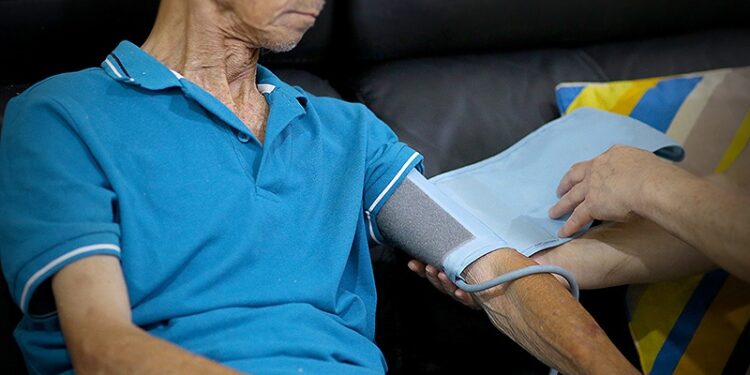BARCELONA, Spain — A “treat-to-target” approach for gout was associated with a modest but significant reduction in the risk for major cardiovascular (CV) events (MACEs) when compared to a “fire-and-forget” approach, according to findings reported at the European Alliance of Associations for Rheumatology (EULAR) 2025 Annual Meeting.
Patients who achieved a target serum urate level of < 360 μmol/L (6 mg/dL) within the first 12 months of starting urate-lowering therapy (ULT) had a 6%-12% lower risk for MACE within 5 years compared with those who did not achieve that target level. The definition of MACE included nonfatal myocardial infarction, nonfatal stroke, or CV death.
“Gout is associated with an increased risk of cardiovascular events,” said Edoardo Cipolletta, MD, a rheumatology consultant at Azienda Ospedaliero Universitaria delle Marche, Torrette, Italy, and a research associate at the University of Nottingham, Nottingham, England.
Although “a temporal association between gout flares and subsequent cardiovascular events” had been described previously, it was not known whether using ULT to achieve a target serum urate level of at least < 360 μmol/L (6 mg/dL) would reduce the risk of CV events, Cipolletta added.
Two Emulated Target Trials
To learn whether ULT might reduce the risk for future MACE, Cipolletta and associates performed two emulated target trials using data from two large-scale primary care databases — the Clinical Practice Research Datalink (CPRD) Aurum in England and the Western Swedish Health Care Register (VEGA) in Sweden.
Both databases are representative of the general population because they are linked to both hospital admission and mortality data, Cipolletta explained.
Two study groups were created: those who had been “exposed” or “unexposed” to a treat-to-target strategy and had achieved a serum urate level of < 360 μmol/L within 12 months of their first ULT prescription. Those in the unexposed group had to have serum urate levels of 360 μmol/L or serum urate levels that had not been measured.
A total of 116,518 patients were included in the analysis; 109,504 from CPRD and 7014 from VEGA. Cipolletta acknowledged that there were some key differences in baseline characteristics before cloning, censoring, and weighting had been performed to make the populations “more homogenous,” but that afterward, the populations were well balanced.
For instance, before the statistical methods were applied, 27.3% of patients from CPRD and 22.1% from VEGA achieved the target serum urate level. The mean age in each group was 62.9 years and 70.0 years, respectively, and 77.8% and 71.7% were men. The mean duration of gout before diagnosis was 2.5 years and 1.1 years, respectively.
Before adjustments, “the use of gout flare prophylaxis was much more diffuse” in the CPRD dataset than in VEGA, Cipolletta said. Conversely, there were more individuals in the VEGA dataset than in CPRD with a history of MACE (12.7% vs 2.5%).
Key Findings
Over a mean follow-up of 2.5-3.5 years, depending on which dataset was used, there was a 1.3%-1.4% difference between the groups in the weighted 5-year MACE-free survival, favoring the treat-to-target approach. Specifically, the 5-year weighted survival rates in those exposed and not exposed to a treat-to-target approach were 89.43% and 88.03%, respectively, in the CPRD dataset and 76.82% and 75.50%, respectively, in the VEGA dataset.
The findings were consistent regardless of whether there was a history of prior CV events or whether the individual MACE components were considered, Cipolletta said.
“We observed comparable results for key secondary outcomes in sensitivity analysis, and we observed significantly lower incidence rates of flare in the treat-to-target ULT arm,” he added.
Data Queried
Ronan Mullan, consultant rheumatologist at Tallaght University Hospital and clinical associate professor at Trinity College Dublin, Dublin, Ireland, questioned the clarity of the baseline urate level comparisons.
He told Medscape Medical News that data had been provided on two separate groups, but baseline data on those who had and had not achieved target urate levels had not been presented.
“There could have been all sorts of confounders,” Mullan said. “I thought that was a bit odd. People with very high urate levels at baseline are also more likely to have cardiovascular comorbidities. I don’t think it was transparent.”
Cipolletta had also been asked by another delegate about the types of ULT that had been used to help people reach the target level because febuxostat had been linked to a risk for CV events vs allopurinol.
He responded that “more than 99% of first ULT prescriptions are allopurinol” in the UK and Sweden. “We included the ULT starting dose and the molecule in the analysis as covariates, but we didn’t stratify for them because there was no power to detect any reliably significant difference.”
The work was funded by a research grant from the FOREUM Foundation for Research in Rheumatology. Cipolletta disclosed receiving speaking fees from Novartis and Institut Biochimique SA, and consulting fees from Horizon Therapeutics. Mullan reported no conflicts of interest.
Sara Freeman is a freelance medical journalist based in London, England.
Source link : https://www.medscape.com/viewarticle/meeting-target-serum-urate-level-cuts-cardiovascular-risk-2025a1000h0c?src=rss
Author :
Publish date : 2025-06-25 07:19:00
Copyright for syndicated content belongs to the linked Source.






